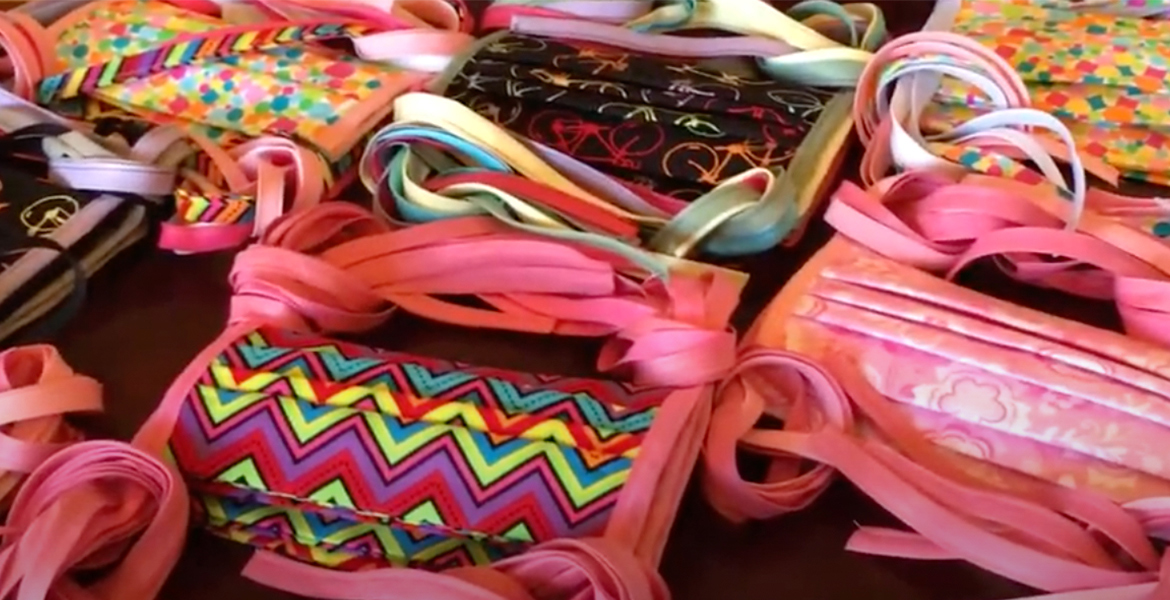
Grassroots volunteers sew thousands of masks
Tuesday, April 21, 2020
Although socially isolated due to coronavirus, a collection of volunteers connected to Oklahoma State University have united to sew more than 27,500 face masks for healthcare workers and others across the state of Oklahoma – and the work is ongoing.
A Stillwater nurse’s Facebook plea for face masks inspired Oklahoma Home and Community Education (OHCE) volunteers, first in Payne County and then across the state, to organize a grassroots effort, said Dea Rash, Payne County Family and Consumer Sciences (FCS) Extension Educator. Their movement quickly crossed paths with OSU.
“The nurse included a link to a pattern,” Rash said. “I included the request for masks in the monthly March FCS/OHCE newsletter, and word quickly got out to other counties via social media. People started sewing, and nearly overnight, it turned into a statewide service project.”
OHCE serves as an outreach of Cooperative Extension, where volunteers are members of local groups meeting monthly to further education and promote university outreach and community service, Rash said. County FCS Extension Educators serve as advisors to the OHCE organization. Payne County has seven OHCE groups with more than 100 members in the county.
Suzette Barta, coordinator for community engagement and extension for the College of Education and Human Sciences, added the efforts expanded even further when an OSU professor utilized an OSU fashion design lab to prepare fabrics for volunteers to sew.
“I was asked by Dr. (Lynn) Boorady if some of the OHCE groups could help sew the masks she had been cutting out,” Barta said. “Payne County was our first priority, obviously, because they are close. However, there have also been a few other counties that have jumped on board.”
Barta said most of the face masks OHCE volunteers sew with their own fabric have been donated individually to healthcare workers and first responders in their own communities. However, Boorady, head of the Department of Design, Housing and Merchandising (DHM), said masks sewn from materials cut by OSU faculty and staff in DHM labs have a more unique delivery path.
“The College of Engineering, Architecture and Technology at OSU has been 3D printing face masks and face shields,” Boorady said. “Then, Engineering is working with OSU Diagnotics Lab, which is doing COVID testing for the state. This lab has a team of drivers who pick up samples, and when they pick up samples they are also now dropping off the face shields and our face masks at testing sites.”
Boorady said volunteers are working quickly to produce masks. Materials for nearly 800 face masks have been distributed to volunteers; 500 more mask kits are waiting on materials; and 250 completed masks have already been returned for distribution. A small business in Oklahoma City, Fabric Mart, has been opening three days a week for three hours, so individuals like Boorady can purchase face mask supplies. Additionally, OSU faculty and staff have spent many hours on the weekend cutting and preparing materials in DHM labs.
Boorady has also produced educational videos to dispel common myths on wearing face masks. Just as she relied on Cooperative Extension to recruit volunteers for sewing face masks, Extension Educators are spreading her messages throughout Oklahoma.
“We can do the research until we’re blue in the face,” Boorady said. “However, Extension educators are the conduit between university research and people in the community, the ones who disseminate the information.”
Barta said other COVID-related educational resources developed by Cooperative Extension cover topics ranging from proper hand washing to how to sanitize a home to family finances and healthy eating. These topics are routinely studied and disseminated by OSU professors and Cooperative Extension Educators when times are calm but become even more important during a pandemic.
“The current situation shows there is still a very strong need for scientific-based information in our communities,” Barta said. “That is exactly what Extension was created to disseminate.”
Rash adds OHCE groups also undertake many additional projects besides sewing face masks. For example, Payne County groups raise money for scholarships, sew tooth fairy pillows for county first-graders, provide meals and gifts for families at holidays, participate in recycling and resource management projects and donate supplies to many local shelters.
Dr. Stephan Wilson, dean of the College of Human Sciences, said these efforts and coordination of volunteers sewing face masks underscore the importance of the land-grant mission.
“Family and Consumer Sciences Cooperative Extension and Design, Housing and Merchandising faculty and staff work closely to positively impact our communities,” Wilson said. “The land-grant mission of instruction, research and Extension ensures research is grounded in practical application and disseminated to our communities who need it most.”
While important every day, Barta said the land-grant mission becomes especially valuable during times of crisis like a pandemic.
“When there's a crisis of this size, you really see what people have in their hearts,” Barta said. “These OHCE members have really stepped up.”
MEDIA CONTACT: Brittany Bowman | 405-744-9347 | brittany.bowman@okstate.edu
